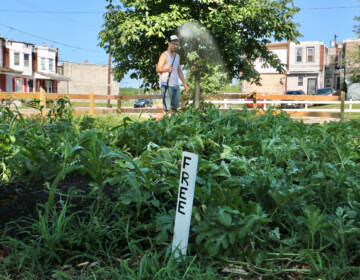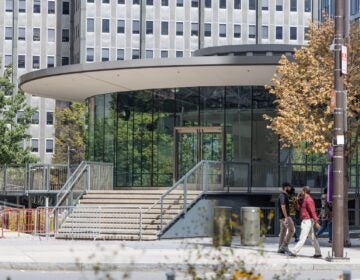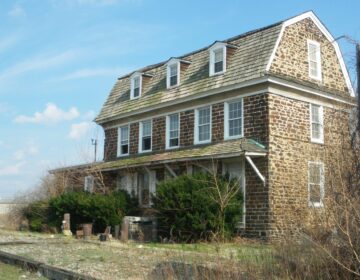What’s riding on dig at SugarHouse site?
Maps courtesy of Kensington historian Kenneth Milano.
Phase I SugarHouse site report courtesy of Hallwatch
Dec. 11
By Kellie Patrick Gates
For PlanPhilly
Some modern-day activists hope the traces of a neighborhood of 18th and 19th century riverward residents can do what their 21st century counterparts so far have not: Relocate the proposed SugarHouse Casino.
Archaeologists – hired by SugarHouse in order to meet the requirements of a federal Clean Water Act permit – have dug up shards of pottery and found remains of house foundations, privies and wells – enough items of interest on the site that contractor A.D. Marble & Associates of Conshohocken recommended a second, more refined phase of excavation that is nearly finished. The first phase started in February.
The artifacts and information will go to the Pennsylvania Historical and Museum Commission for review. The Commission will then determine whether or not the findings warrant more investigation, and will make a recommendation to the Army Corps of Engineers.
Jeremy Beaudry, a founding member of Neighbors Allied for the Best Riverfront, thinks there may be enough historic evidence at the Delaware Avenue site to force the relocation, or at least the delay, of the slots operation. “We’ve got this amazingly historical riverfront that has been largely covered over by generations of industry. Now we have this chance to kind of unearth the layers of history,” Beaudry said.
Terry McKenna, project executive for Keating Consulting – the general contractor for SugarHouse – said the likelihood of any significant findings is “very slim” because “whatever was there was demolished and replaced by industrial uses.”
The area of interest is contained within the rectangle made by the former Laurel Street, Ellen Street, Delaware Avenue and the river, he said. Some buildings were demolished to make room for a coal-fired electric plant that was constructed to support the rail lines, and others were removed to support a rail yard. The only small areas where anything of interest could still exist are the small places that “were lucky enough not to be disturbed” in all the activity, he said.
It’s too early to determine who is right, said Jane Crawford, press secretary for the Pennsylvania Historical and Museum Commission, the state agency that will decide the historic importance of anything the excavators find. Thursday, PlanPhilly received an email from a local attorney with accompanying maps that show a British revolutionary fort on or close to the proposed SugarHouse site.
The federal permit comes with a requirement that efforts be made to save history, which is why the Commission advises the Army Corps of Engineers – the agency that issues Clean Water Act permits. Based on what is found and reported, the Commission will make a recommendation to the Army Corps.
“We have not seen any of the artifacts at this point,” Crawford said. McKenna hasn’t either, so he couldn’t describe them in detail. Only A.D. Marble could, but SugarHouse’s contracts prohibit their contractors from speaking to the media. McKenna said that the archeologists on the project were “not excited” by what they were finding.
McKenna expects the Phase II report will be finished soon, as digging ended last week. Even if Marble recommends a third phase of searching, the dig would be confined to a very small area, McKenna said. “We’re talking literally a few square feet here, a few square feet there,” he said. “None of this archaeology stuff will stop us from construction,” he said.
But when asked if all aspects of construction could begin before the archaeology is finished, Crawford said “probably not” because the Army Corps of Engineers will not issue a permit until after her Commission makes its recommendation, and that won’t happen until the Commission is satisfied that enough digging has been done.
SugarHouse needs the Clean Water Act permit for portions of the project that have an impact on the Delaware. It cannot work on any such portion until the permit is issued. This permit has no effect on aspects of the project that do not impact the waterway, said Army Corps spokesman Ed Voigt. So the casino could begin construction away from the water without the Clean Water Act permit in hand.
Based on research of historic maps and writings, the Commission already knows some things about the people whose homes were clustered at the intersection of Laurel Street – now a drainage right-of-way – and Delaware Avenue.
One map from 1859 shows that just south of the homes, there was a park of open land where people could walk, sit and look at the Delaware, or have a picnic, she says. She did not know when the park was created or when it disappeared.
McKenna said there was also a tavern and a bank in one area.
Crawford said her agency hopes to “develop a profile of what this area was like in the 18th and 19th century – which is why we are interested in seeing whatever artifacts are available. They will have research potential for us.”
Before the days of public trash removal, people often used privies and wells as trash disposal areas, she said. The shafts archaeologists have found in former yards may contain discarded household items, such as cooking utensils and dishes. Even a small bone fragment can show what people ate for dinner in the 1700s, Crawford said. The types of plates and utensils could show how they cooked and ate their meals, and their relative wealth.
Crawford said her agency will make its recommendation to the Army Corps of Engineers within 30 days of receiving the A.D. Marble report.
The Army Corps will also consider environmental impact and a host of other factors when deciding whether to issue the permit, including input from other agencies, and, potentially, some of the activists.
Army Corps procedure allows groups, organizations and individuals to apply to be a consulting party, said Jim Boyer, a biologist with the Army Corps’ Philadelphia office. Several entities are in the process of applying, including NABR, The Northern Liberties Neighbors Association and John Connors, director of the on-line Penn Treaty Museum and a driving force behind the Friends of Penn Treaty Park organization.
Applicants have to show that they have a legitimate interest to be selected as a consulting party. Some, including NLNA member and history buff Hilary Regan, are concerned that the fact they oppose the proposed casino will keep them from being selected.
“This is not really about being anti-casino,” she said. “It’s about preserving our heritage. You have to separate the two.”
NABR’s Beaudry said a significant archaeological find would “certainly come into alignment” with NABR’s goal of casino location, but NABR is “very sensitive to land use issues,” and pending what the archaeological survey reveals, he could envision ” a historical interpretive center(s) that features artifacts, stories, histories of the many generations who have settled, lived, and labored on the waterfront.”
Boyer said that generally, giving an explanation of why they are interested in the historic nature of a property is enough to get consulting party approval. His agency is now waiting to receive those documents. Once the parties are selected, a meeting will be held to bring them up to date in the process, and they will be continually kept informed, he said. And they can voice opinions and concerns to the Corps.
The general public can submit comments in writing, he said. Anyone can request a public hearing on a particular permit, but it is up to the Corps to decide if one is necessary, and they are rarely held.
Both Connors, of Penn Treaty Park, and Beaudry, of NABR, say that the scope of the current dig is not big enough.
NABR has been consulting with archaeologist Joel T. Fry, who in a memo to NABR disagreed with Marble’s determination that there is little likelihood of finding pre-contact Native American artifacts on the site. Fry “believes there is potential for substantial finds below the landfill that happened when the piers were built out,” Beaudry said.
Crawford, of The Historic and Museum Commission, said that there was no evidence of Native American activity on the SugarHouse site “to our knowledge.”
Connors believes Lenape chiefs gathered at Shackamaxon, but he also believes continued digging could turn up artifacts from the British encampment during the American Revolution.
Boyer, with the Army Corps, said that SugarHouse’s permit application is not yet complete – he sent it back with a request for more details on portions of the plan and other questions, a typical occurrence. Once a complete application is in hand, the Corps will issue a public notice of the comment period – which in this case will likely be 30 days. While the Corps tries to act on all applications within 60 days, Boyer assumes this one, with all the expected comments, will take longer.
Kellie Patrick Gates is a former Inquirer reporter. Contact her at kelliespatrick@gmail.com
WHYY is your source for fact-based, in-depth journalism and information. As a nonprofit organization, we rely on financial support from readers like you. Please give today.






